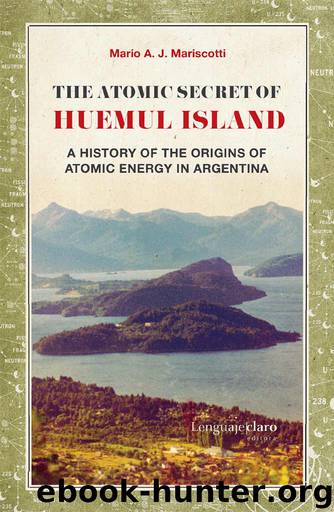The Atomic Secret of Huemul Island: A history of the origins of atomic energy in Argentina by Mario A. J. Mariscotti

Author:Mario A. J. Mariscotti [Mariscotti, Mario A. J.]
Language: eng
Format: epub
Published: 2017-07-13T03:00:00+00:00
4 | Crisis (March – December 1951)
The Press Conference
On Easter Sunday, March 25, 1951, Richter held a press conference on his own. Perón put the presidential residence in suburban Olivos at his disposal, a wonderful setting especially that day in which the weather was nearly perfect. A score of journalists gathered around the scientist to hear further details on the fantastic experiments at Huemul announced the day before.
Colonel Gonzalez and his son, who as usual, acted as interpreter, accompanied Richter. The Information Secretary Raul Apold, Plantamura and other senior officials were also present. A picture in the newspapers the following morning shows the group standing outdoors around Richter who, in shirtsleeves, looks much more relaxed than the day before besides Perón at the Casa Rosada.
Richter was evidently at ease: he talked for three hours. Without Perón he was master of ceremony. He could run the show as he pleased. Nobody would rush him. Abundant credit he enjoyed to have everyone's ears eager to listen to him. His speech was published in full by most local newspapers. If the importance of a topic can be measured by the space given to it by the press, then that was the day for nuclear physics. In essence, Richter's speech was a good lecture in basic nuclear physics. For he did show uncommon ability to explain the intricacies of nuclear science to the non-initiated, a trait which had served him well two years earlier when expounding his ideas on atomic fusion to Perón.
He started explaining that Atomic Energy stemmed from the famous mass energy equivalence discovered by Einstein. He then described the structure of the atomic nucleus. He spoke slowly and used his hands to help shape his ideas. The translation, with its regular pauses, made the discourse seem even more academic. He explained in some detail how to obtain energy by splitting nuclei of uranium 235 or plutonium 239, or conversely, by fusing light elements such as hydrogen or lithium.
After a while, the lecture became a bit monotonous. It did not help when he rambled off and started talking about mesons, which have little to do with thermonuclear reactions. But it was only a short detour. His audience must have been relieved when he reconsidered, "this, however, is an extremely complicated story, we could go on talking for hours."
Journalists tried to concentrate on everything he said, waiting for the moment he would turn to the experiments done on the island. Yet Richter continued to elaborate on isotopic numbers, multimillion figures and chain reactions. He mentioned related developments carried out by the US, England and Russia, "where factories a mile long are presently being built", adding that "the sole factor which can explain the need for such huge factories is the demand imposed by war".
Richter repeated what he had told Perón: the path elected by the US to produce tritium for the first hydrogen bomb was wrong. "Had Argentina decided to follow such a path, we would have been forced to travel the long way of uranium.
Download
This site does not store any files on its server. We only index and link to content provided by other sites. Please contact the content providers to delete copyright contents if any and email us, we'll remove relevant links or contents immediately.
The Complete Stick Figure Physics Tutorials by Allen Sarah(7262)
Secrets of Antigravity Propulsion: Tesla, UFOs, and Classified Aerospace Technology by Ph.D. Paul A. Laviolette(5236)
Thing Explainer by Randall Munroe(3844)
The River of Consciousness by Oliver Sacks(3493)
The Order of Time by Carlo Rovelli(3093)
How To by Randall Munroe(2965)
A Brief History of Time by Stephen Hawking(2908)
I Live in the Future & Here's How It Works by Nick Bilton(2898)
The Great Unknown by Marcus du Sautoy(2611)
What If?: Serious Scientific Answers to Absurd Hypothetical Questions by Randall Munroe(2585)
Midnight in Chernobyl by Adam Higginbotham(2429)
Blockchain: Ultimate Step By Step Guide To Understanding Blockchain Technology, Bitcoin Creation, and the future of Money (Novice to Expert) by Keizer Söze(2406)
Networks: An Introduction by Newman Mark(2301)
The Meaning of it All by Richard Feynman(2266)
Easy Electronics by Charles Platt(2248)
The Tao of Physics by Fritjof Capra(2200)
Midnight in Chernobyl: The Untold Story of the World's Greatest Nuclear Disaster by Adam Higginbotham(2125)
When by Daniel H Pink(2056)
Introducing Relativity by Bruce Bassett(2045)
